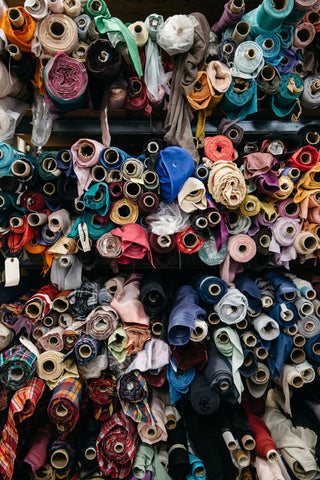What is Deadstock Fabric?
Deadstock fabric is a term used to describe unused materials that have been manufactured for clothing or accessories but never sold. The name comes from the fact that these materials are "dead"--they've already been produced and no longer have any commercial value.
Deadstock fabric is an eco-friendly alternative to regular textiles. Many clothing brands and fashion designers use it to promote recycling, mindful consumption, and waste reduction.
The main advantage of deadstock fabric is its lower cost compared to conventional textiles used in the fashion world. This kind of fabric also gives us new purpose to textile waste that would otherwise end up in landfills.
The Unsustainability of Deadstock Fabric
Although deadstock offers many benefits, it is not an environmentally conscious choice as it seems. It feeds off the overflow from fast fashion and creates the illusion of sustainability. Many manufacturers intentionally produce more fabric than they need as they know the surplus will eventually sell.
If all textile manufacturers and clothing brands kept their production to the required minimum, deadstock fabric wouldn't even exist. Buying and using deadstock contributes to its rising demand as more and more consumers are concerned with the environmental impact of their clothing purchases.
Overproducing textiles and garments doesn't even cost more to manufacturers. It's more cost effective to overproduce rather than limit their stocks and eventually miss out on lucrative opportunities.
Throwing away any fabric surplus that may not get sold barely costs anything at all. Most manufacturers don't even want to lose their time with smaller production runs, so fashion brands are forced to place huge fabric orders that largely exceed their needs to cater to production minimums.
Ultimately, it's difficult to doubt the good intentions of small clothing brands that use deadstock. However, some critics still consider deadstock as a form of greenwashing.
Deadstock isn't the most sustainable fabric available today. The most sustainable fabric we can use is what has already been produced and worn. There is enough clothing on the planet right now to dress the next six generations of the human race. Wear what already exists!
What Can Be Done to Reduce the Unsustainability of Deadstock Fabric?
While we can't do much about the fact that deadstock fabric is produced in such huge quantities, there are some things you can do to reduce its impact on the environment.
- Reduce consumption of deadstock fabric by buying less clothing and accessories. If you have an item of clothing or accessory that no longer fits, but is still in good condition and has sentimental value to you, consider passing it along to someone else who will appreciate it instead of throwing it away. This will help ensure that fewer new items are made from virgin materials and more used ones are repurposed for other purposes like rags or stuffing toys (which may also be made from recycled plastic bottles).
- Reuse deadstock fabric as rags for cleaning around the house or crafting projects like quilts or wall hangings instead of throwing them away when they become worn out beyond repair--you might even be able to sell these creations online!
Conclusion
There is a lot of deadstock fabric in the world. It's not going away anytime soon, and it will continue to be used in clothing production until there are no more trees left on Earth. But if you want to be part of the solution rather than the problem, here are some ways you can help:
- Buy less stuff! If you only buy what you need and use all of it before buying more (or making new), then there will be less demand for new products made from old ones.
- Buy secondhand clothes instead of new ones whenever possible--they're just as stylish as their fresh counterparts at half the price! This way we reduce our use of resources like water and energy while also keeping usable materials out of landfills; plus we get an awesome wardrobe upgrade without spending any extra cash!
- Support companies who use sustainable practices such as upcycling, and selling second-hand.
